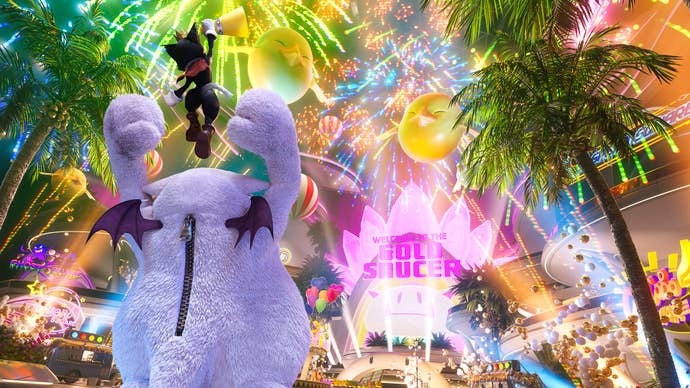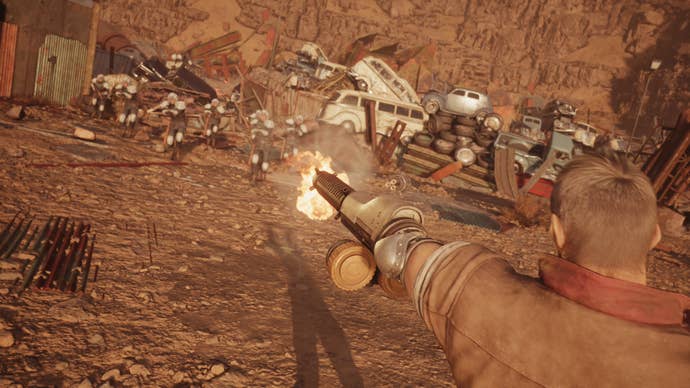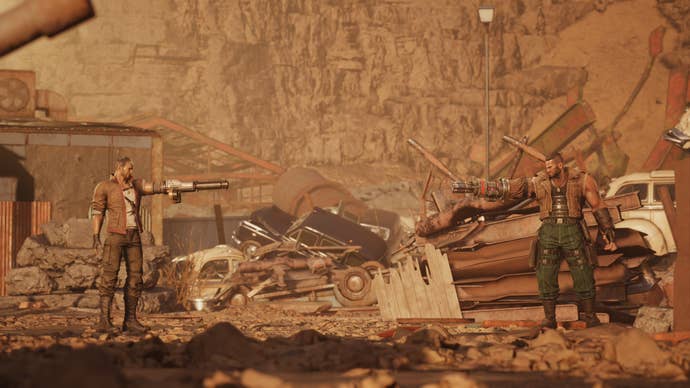Products You May Like
There are many places across both Remake and Rebirth that you can point to this sort of thing; a place where the new games lack the bite of the original.
The most obvious example up until now is FF7’s ‘Trail of Blood’, a truly iconic and creepy sequence in the original game that, in the modern version, replaces streaks of blood throughout previously shiny and sanitized corporate offices with a sort of weird glowing purple alien goo. The music is the same, but the mood is wrecked by the change; the sequence undermined.
To be fair, that’s the prime example because it’s the worst of the bunch. Most of the time, Square Enix’s careful recreation of scenes from FF7, even when changed, land perfectly. In fact, the second part of the Remake trilogy, Rebirth, never really misses. With that said, it’s also fair to say that on many occasions, the events it depicts lack some of the heft and punch of the original.
There’s a raft of new examples of this in FF7 Rebirth, a game that covers several pretty traumatic events for the cast of FF7. There’s quite a few examples that I could talk about – but by way of example, I want to zero in on one – the storyline of Barret and Dyne in Chapter 8, around halfway through the game.
As a result, from here on in this article contains spoilers for up to and including Chapter 8 of FF7 Rebirth. You have been warned.
The storyline of FF7 is of, course, about saving the planet from evil corporations and malevolent aliens, but peppered throughout are vital character vignettes. Barret’s big moment comes when the team visits the Gold Saucer.
En route he passes through his home village, where he is inexplicably reviled – and then eventually comes face-to-face with his best friend, who he long thought dead. Through the course of this story we learn the origin of Barret’s daughter Marlene (whose being a different race to him isn’t up to this point addressed), plus learn about his involvement in Shinra’s destruction of his home town.
It’s an important moment. We learn a lot about Barret’s origins, his motivations, and can put a finger on exactly why he’s so angry about Shinra earlier in the story. It’s also an emotional story – about brothers who are torn apart and ultimately forced to fight each other by the forces of evil.
All of these events are present in Rebirth – but they have been subtly adjusted – and in many ways for the worse.
Rebirth adjusts things ever-so-slightly here. For one, in the original game, the hatred the people have for Barret goes unexplained until later. In Rebirth, it’s explained right away, Barret revealing his story to the party in flashback. This introduces you to Dyne, reveals he and Barret were both gravely injured, and also makes clear that it was Shinra, not them, who was to blame. The flashback changes other small details, too; Corel is depicted as a ramshackle mountainside shanty town of sorts even before the disaster – whereas in the original the flashback Corel is visibly a much more prosperous town. But the real change begins to emerge once you arrive at the Gold Saucer.
In the original FF7, Barret arrives at the Gold Saucer in a bad mood, having been through a nasty experience in visiting his ruined hometown and been rejected as a traitor by its inhabitants. Barret storms off without much of a word, and the next thing you know, you’re hearing about a man with a gun for an arm shooting up one of the zones of the giant theme park you’re in. The game teases it out: could Barret have done this? Has he snapped and killed a bunch of innocent people? In our hearts, we know the answer – it’s unlikely an RPG party member would turn so absolutely and so quickly – but a flicker of doubt is there.
In this, Rebirth tips its hand subtly; the edges must be sanded off this narrative. So in Rebirth, we see a cut-away scene of Barret notice another man with a gun for an arm in the Gold Saucer, before we learn about the slaughter. Barret follows the man. When news of the mass shooting breaks, the party worries that Barret is responsible, but we as an audience already know the truth: it was this other mysterious dude.
That man turns out to be Dyne, Barret’s long lost friend from his hometown. The injury that led to Barret’s arm being amputated and replaced by a gun was also suffered by Dyne, in mirror – Barret lost his right arm, Dyne his left. Both independently had guns grafted to their bodies for the same reason – to seek revenge. It turns out that Marlene is actually Dyne’s biological daughter, adopted by Barret in the wake of the disaster that destroyed the town of Corel, and left everyone else in Barret’s life – most notably Dyne, Dyne’s wife, and his own wife – dead. As it happens, Dyne did survive.
In both games, the Dyne we meet in the shadow of the Gold Saucer has lost his grip on sanity, ruined by the loss of his wife, daughter, and home – and by the brutality of the years since.

In the original, however, Dyne has a clearly stated goal. He says he wants to “destroy everything” – and that’s why he heads up to the Gold Saucer and slaughters a bunch of random innocents. He’s acting out, basically. When Dyne finds out Marlene is alive, his mind goes to only one place: his daughter has to die. She should, he reasons, be with her mother – and it’s Dyne’s duty to “take her” to her late mother. This is ultimately why Dyne attacks Barret, and why Barret counters – Barret stands in the way of Dyne killing Marlene.
In FF7 Rebirth, the scene is markedly different. Dyne attacks Barret ultimately because he’s just mad about what happened in the past. He also sees Cloud’s uniform and mistakes him for a Shinra SOLDIER, which riles him up more. Barret and Dyne. It’s only after they’ve fought that he even finds out Marlene is still alive.
The sequence really unravels for me from here. Suddenly, Shinra soldiers show up en masse. At first I thought this was to give the rest of the cast a distraction to keep them away from Barret and Dyne’s showdown. It does serve that purpose – but the soldiers also they make their way to the gun-armed duo, too. An emotional scene between two broken friends is undercut by a platoon opening fire on them.
In the end, Rebirth’s Dyne takes a load of bullets from Shinra soldiers – and essentially saves Barret’s life, as when the soldiers show up Barret’s gun arm is unequipped, having been knocked off in their duel. In that sense Dyne goes out in a blaze of glory, to some extent. Plus in the unhinged state the game presents, and with his hatred of Shinra, he would’ve attacked these soldiers anyway, to save Barret or otherwise. The original game’s Dyne has a very different end; coming somewhat to his senses, he reasons he’s done too much evil, his hands too bloodsoaked, to ever reunite with – or not be a danger to – his daughter. Dyne then jumps off a cliff to his death.
.jpg?width=690&quality=70&format=jpg&auto=webp)
What’s interesting is that the Rebirth scene certainly isn’t bad. John Eric Bentley, the voice actor behind Barret in the English version, turns in an incredible performance here. As Dyne lays dying, Bentley’s Barret lets out a gut-wrenching cry that gives way to sobs; it put a lump in my throat. The cutscene direction is beautiful. The dusky time of day the events take place in is perfect for a wild west showdown between two gunmen. It’s really good. But it’s not as good, you know?
Never mind that the very next thing that happens after that gut-wrenching scene – literally a minute later – is a boss fight against a comic relief villain in a giant frog-like mech. The scene itself just feels undercut.
I can see why the developers might’ve taken a step back and decided that having an attempted infanticide be a major plot point might not be something they’d want to do in 2024. Likewise for Dyne taking his own life as opposed to having it snuffed out by enemy soldiers in a desperate last stand. But, being real, and for all that I love about the new scene, I still think the original, more raw version is ultimately better.
I feel similarly about a lot of moments in the game – like how the spooky environment of the events with Jenova on the cargo ship are replaced with a more bombastic rush and a series of escalating battles. It’s a largely bloodless affair – though I say this knowing that the cutscene immediately before the boss fight there is, I think, one of the single best in the game.

Like the trial of blood in Remake’s nerfing, or the watered-down body horror elements of Jenova’s existence, a lot of this feels like a decision to avoid anything in the game being too raw. Final Fantasy 16 might’ve been a bloody M-Rated affair, but FF7 Remake and Rebirth are T for Teen all over. That’s for good and for ill.
Indirectly, FF7 Remake’s bosses have explained this, too. Speaking during a recent BAFTA event, original FF7 director and Remake series Producer Yoshinori Kitase actually bought up ratings – and aiming for something more widely acceptable – as a key target for Rebirth.
“I’m not criticizing this at all, I think you very much do need these kinds of more extreme expressions of things, and depictions of things which are a little bit quirky, a little bit weird,” Kitase says of more expressly violent games. “But I think to be widely accepted by mainstream culture we have to go for the middle ground as well and have more generic, more mainstream depictions of things which are just normal and average, and strive to make those portrayals as realistic as possible.”
“That’s something that we are striving for in Final Fantasy. Again, all that extreme, out there stuff – that’s all great and we need that too. But we need to have a bit more of a balance as well.”
Kitase’s words make perfect sense. And really, it doesn’t hurt Remake or Rebirth that much in the grand scheme of things. At the same time, however, I do mourn for the original versions of scenes like Trail of Blood, the Cargo Ship, Barret and Dyne’s showdown, and others. I also wonder if a development team as laser-focused on the mainstream would’ve even be able to make a game as texturally rich as the original FF7.
Times have changed, and I love what we’ve got – but still miss what we’ve lost – and it’s a perfect reminder of why the original will always be untouchable.
